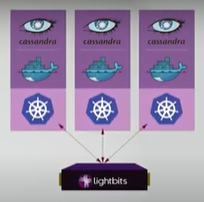With the constant growth of data in the forever available data center, one of the critical challenges is to make cloud-native applications and services running at scale migrate around the data center so that services remain available. Running containerized applications on persistent storage addresses these requirements as containers can be quickly spun up anywhere and terminated with minimal overhead.
Overview
- Demonstration of Cassandra Workload on Persistent Volumes
- Container Migration for Cloud-Native Applications
- How Lightbits compares to DAS
- Conclusion
Demonstration of Cassandra Workload on Persistent Volumes
Follow along with this lab demonstration of the Lightbits solution for a Cassandra workload in a containerized environment. We tested how fast container migration is achieved in a Kubernetes cluster with the Cassandra containers connected to Lightbits persistent volumes via the Container Storage Interface (CSI). We also tested the performance and low latency possible when disaggregating NVMe SSDs from containerized Cassandra nodes to Lightbits.
Lightbits is a software-defined, disaggregated solution that separates storage and compute and maximizes utilization of the infrastructure. Lightbits storage interface provides a remote pool of NVMe SSDs that can be shared with compute nodes anywhere in the data center using NVMe over TCP and deliver performance and latency that’s equivalent to local SSDs.
One of the critical challenges is that applications and services running at scale need to remain stateful as they migrate across the data center to keep services up. Using a containerized environment addresses these requirements because you can quickly spin up containers anywhere and bring them down with little overhead.

Architectural illustration of containerized applications in Lightbits persistent volumes.
Here we have a Cassandra cluster being managed by Kubernetes with three active nodes. Each of the nodes has a containerized Cassandra application running on it and they’re disaggregating their storage over persistent volumes to Lightbits software-defined storage.

Cassandra cluster disaggregating storage over persistent volumes to Lightbits software-defined storage.
What we ran in the lab is a YCSB workload of three nodes and we see just one node here on the dashboard, where we got 40,000 transactions per second. We ran this exact same experiment with the NVMe SSD directly installed in the DAS configuration for each Cassandra node. That’s shown here in one column. And then as we’re getting these 40,000 transactions back we show the read and update average latency as reported from Lightbits to the application. And then you see the read and update tail latency. On the average side, we’re very close to DAS, which is pretty incredible. But at scale, it’s the tail that is really key. And that’s what we’re showing here in the green boxes where Lightbits is 5% lower for read tail latency and for update tail latency.

Lightbits persistent storage for containers delivers performance equivalent to DAS.

Persistent volumes for containerized applications that is 5% lower for read tail latency and for update tail latency than DAS.
The results of these lab benchmarking tests prove that Lightbits delivers the same transactional performance as directly attached NVMe SSDs but with better I/O tail latency to containerized applications.
Container Migration for Cloud-Native Applications
We tested a Kubernetes pod, logged in with the Kubernetes CLI to monitor and actually drain one of the nodes so that it evicts the Cassandra containerized application from one node and then brings in a new node to simulate a maintenance operation and see how fast that happens using our persistent volumes through the container storage interface plugin from Lightbits.
On the Kubernetes CTL we give it the command to drain and Kubernetes takes that pod out. It will terminate one of the three pods and evacuate it and spin up a new pod. The wall clock time for this action is about 67 seconds. And that’s because it’s simply getting a hinted handoff and saying okay, here new Cassandra container points to this Lightbits persistent volume using that container storage interface.

Migrate containers in about 67 seconds using Lightbits persistent volumes.
How Lightbits Compares to DAS
The comparison is completely relative to how much data has to be rebuilt on a new Cassandra node that’s been spun up. So Direct Attached is data-dependent. If you have terabytes of data that have to be rebuilt on one node, that’s going to take a long time. With Lightbits you get dramatically faster migration of containers. With Lightbits it’s a minute and with direct attached storage it could be hours.
Conclusion
This blog has illustrated how the Lightbits solution can dramatically improve operational efficiency for containerized applications with latencies that are as good or better than direct attached storage and all this with simple and efficient NVMe over TCP. No need to touch the clients or the network, containers are easy to deploy at scale with Lightbits.
As container ecosystems mature, constraints on the implementation of containerized applications keep falling away. The finalization of the industry standard known as the Container Storage Interface (CSI) is an improvement that paves the way for the deployment of storage system-agnostic applications for leveraging stateful containers.
The Lightbits CSI plugin works with NVMe/TCP-based Software-Defined Storage (SDS) solution. Lightbits is ideal for containerized applications that require clusters with persistent storage for rapid node migration, workload rebalancing, or recovery from failures without copying data over the network.
Lightbits unlocks the potential of a disaggregated high-performance NVMe solution to maximize resource utilization and flexibility and enables data centers to move from an inefficient direct-attached SSD model to a shared model with independently scaled compute and storage.
Combining the power of Lightbits with the standards-based CSI plugin interface just makes sense. Remove the drama required to create stateful containers with Lightbits cloud storage based on NVMe/TCP.

